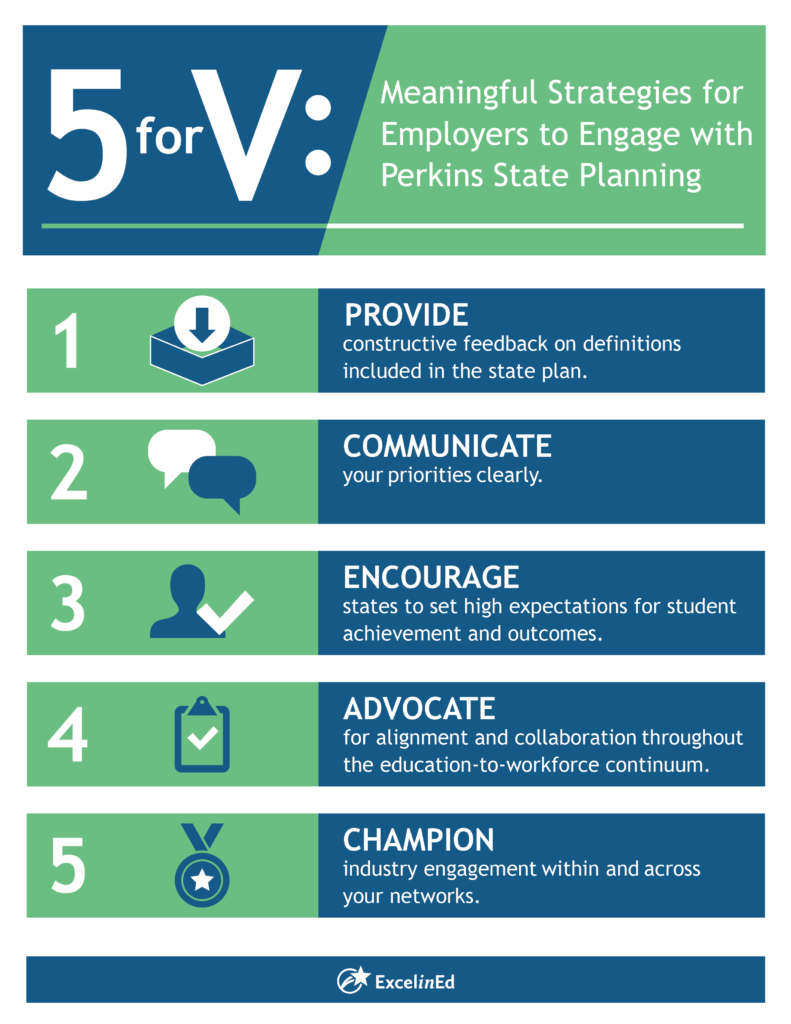Melissa Canney is the Director of Innovation Policy for ExcelinEd.


Ensuring today’s students are prepared for tomorrow’s careers increasingly depends on employer engagement in workforce education. This is especially important given the 2018 reauthorization of Perkins V, the federal law and funding stream that supports K-12 and postsecondary career and technical education (CTE).
Employer participation in the development of each state’s Perkins V plan is more than just a federal requirement; it is an invaluable opportunity for employers to weigh in on their state’s vision for workforce education. It is also an opportunity to cultivate strong and long-lasting partnerships between employers and education systems.

For employers participating in the Perkins V state planning and implementation process, it’s important to remember that “CTE is not a jobs program; it is a sequence of rigorous education and training that can help provide a lifetime of economic mobility for families and build long-term prosperity for states, regions and cities.”1 The most impactful employer engagement will reflect long-term strategic priorities and will focus on developing a robust talent pipeline rather than simply filling currently vacant positions.
What are specific ways employers can engage in the Perkins V State Planning process?
States are required to define size, scope and quality for their workforce education programs, but they can include other definitions as well. Strong state plans will include clear definitions for the various components of a high-quality program of study. Ideally, the programs will focus on student outcomes, not just program inputs. Consider these eight “CTE Program non-negotiables” as a foundation for strong definitions and state visions for CTE.
Be specific about the knowledge, skills and credentials needed for your future workforce. When submitting comments/recommendations, provide data or evidence to support your recommendations. This can be especially valuable if your industry is changing/emerging in ways that may not yet be reflected in labor market data.
Support from the employer community can provide important cover for states to set ambitious goals – especially when that support is matched with a commitment of ongoing partnership. Advocate for your state to report on the outcomes/information that are most helpful for you as an employer, either as part of Perkins accountability or through another transparency reporting channel.
Strong state plans will clearly articulate how multiple agencies (K-12, postsecondary and workforce) will work together to implement seamless career pathways for all students. This could include strategies to expand access to early postsecondary and work-based learning opportunities within career pathways, as well as joint investments between secondary and postsecondary institutions.
Share the importance of employer engagement with your industry associations, members of local chambers, etc. While businesses may directly compete against one another in terms of their products and services, everyone benefits when the state’s talent pool (future workforce) is equipped with the knowledge and skills needed for success in family-sustaining careers.
While each state’s Perkins V planning process and timeline varies, the law requires states to engage employers in the initial plan development, at public hearings and through formal public comment. States may also establish additional employer engagement opportunities. Here are a few actions employers can take to get involved today:
